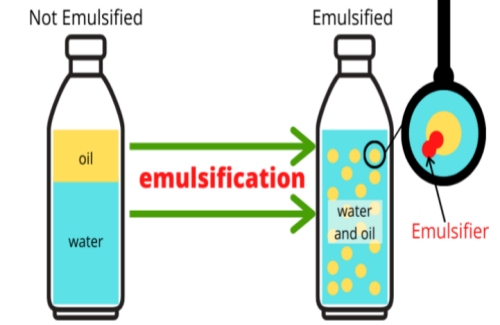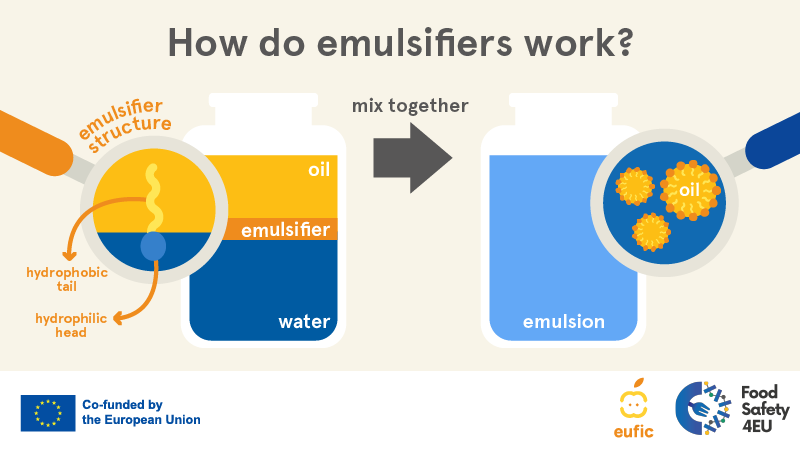Using Emulsifier In Food to Elevate Culinary Presentation
Why It Is Needed to Include an Emulsifier in Food for Optimal Preference and High Quality
Emulsifiers play an important role in food manufacturing by making sure the stable mixing of immiscible fluids, such as oil and water. They lower interfacial tension, which protects against the separation of components and adds to a consistent appearance. This not just improves mouthfeel but additionally affects flavor understanding. Understanding the need of emulsifiers reveals deeper understandings right into their feature and value in cooking applications. What effects does this have for food advancement and consumer preferences?
Understanding Emulsifiers: The Basics
Emulsifiers play a crucial duty in food science, working as agents that assist in the blending of 2 immiscible liquids, such as oil and water. These substances have both hydrophilic (water-attracting) and hydrophobic (water-repelling) residential properties, which allow them to support solutions. Typical emulsifiers include lecithin, located in egg yolks and soybeans, and mono- and diglycerides, originated from fats.
The Science Behind Emulsification
When 2 immiscible fluids are combined, the process of emulsification becomes essential for accomplishing a steady mixture. Emulsification includes distributing one liquid within one more, commonly oil in water or the other way around. This procedure occurs with mechanical frustration, which breaks the larger droplets into smaller ones, thereby boosting the surface area. However, without the visibility of emulsifiers, these droplets would certainly coalesce, resulting in separation.
Emulsifiers are molecules with hydrophilic (water-attracting) and hydrophobic (water-repelling) properties. Their unique structure allows them to minimize the interfacial tension in between the 2 immiscible fluids, maintaining the emulsion. This stablizing stops splitting up and boosts the harmony of appearance and flavor. The interactions at the molecular level are essential for keeping the stability of the solution, making certain that food keep their preferred uniformity and taste. Comprehending this scientific research is substantial for food scientists and producers in developing top quality food.
Types of Emulsifiers Made Use Of in Food
The sorts of emulsifiers made use of in food can be generally categorized into natural and synthetic selections. Common food emulsifiers, such as lecithin and mono- and diglycerides, play an essential duty in enhancing food security and structure. Recognizing these distinctions is vital for valuing how emulsifiers add to the general top quality of foodstuff.
All-natural vs. Synthetic Emulsifiers
While both synthetic and natural emulsifiers serve the crucial function of stabilizing combinations in food, their qualities and beginnings vary markedly. Natural emulsifiers, originated from plant or animal sources, include lecithin, casein, and certain gums. They are commonly viewed as much healthier alternatives, appealing to consumers looking for clean-label products. In comparison, synthetic emulsifiers, such as mono- and diglycerides, are chemically engineered and might supply enhanced stability and capability in a larger variety of applications. These synthetic options can be more affordable and give constant high quality. However, they may evoke hesitation amongst health-conscious customers. Eventually, the choice in between natural and artificial emulsifiers depends upon the preferred qualities of the food, consisting of texture, taste, and shelf-life security.
Usual Food Emulsifiers
Emulsifiers play a vital duty in the food sector, making sure the stability and structure of numerous products. Usual food emulsifiers consist of lecithin, mono- and diglycerides, and polysorbates. Emulsifier In Food. Lecithin, stemmed from resources like soybeans and egg yolks, is extensively utilized in baked goods and chocolates. Mono- and diglycerides, typically acquired from vegetable oils, boost the creaminess of margarine and gelato. Polysorbates, artificial emulsifiers, are often discovered in salad dressings and sauces, promoting a smooth consistency. Various other emulsifiers such as xanthan gum and guar gum, both all-natural thickeners, also contribute to the wanted texture in numerous food items. Each emulsifier kind offers specific objectives, adding to the overall high quality and appeal of food things

Duty in Food Security
Food stability is significantly influenced by the sorts of emulsifiers utilized, which help avoid the splitting up of ingredients in various formulations. Emulsifiers such as lecithin, mono- and diglycerides, and polysorbates play vital roles in maintaining the harmony of products like dressings, sauces, and gelato. Lecithin, stemmed from soy or egg yolk, is particularly effective as a result of its all-natural residential properties, while mono- and diglycerides boost appearance and service life. Polysorbates, on the various other hand, improve the stability of oil-in-water emulsions, making them perfect for baked products. The option of emulsifier depends upon the particular food application and preferred qualities, making sure that items stay steady, enticing, and of excellent quality throughout their designated service life.
How Emulsifiers Improve Appearance and Mouthfeel
Enhancing the sensory experience of food, emulsifiers play a necessary function in improving you could check here structure and mouthfeel. These substances help with the consistent circulation of active ingredients, allowing for a smoother and creamier consistency in products such as dressings, sauces, and ice lotions. By stabilizing combinations of oil and water, emulsifiers protect against separation, resulting in a natural structure that enhances the total eating experience.
Emulsifiers can change the thickness of food products, adding to a desirable thickness or creaminess. This alteration of texture can influence just how food pop over to this site feels in the mouth, impacting complete satisfaction and pleasure. Additionally, by developing a stable solution, emulsifiers assist preserve the honesty of the item, making certain that the desired mouthfeel is consistently provided with time. Overall, the application of emulsifiers is crucial for achieving the appropriate structure and mouthfeel, eventually boosting the high quality of food.
The Function of Emulsifiers in Flavor Improvement
Taste improvement in culinary applications typically depends upon the effective use emulsifiers. These compounds facilitate the blending of water and oil, permitting the even circulation of taste compounds within food items. By producing secure solutions, emulsifiers help to encapsulate and release volatile flavors, boosting the general sensory experience.
On top of that, emulsifiers can improve the understanding of preference by influencing the mouthfeel and structure of recipes. A smoother, much more natural product can cause an enhanced perception of tastes, making them a lot more enjoyable and noticable. Emulsifiers can secure delicate flavors from deterioration, ensuring that they continue to be intact throughout processing and storage.
Emulsifiers in Popular Food Products
How do emulsifiers add to the texture and security of preferred food products? Emulsifiers play an essential function in different extensively consumed items. In salad dressings, they ensure a smooth mix of oil and vinegar, protecting against splitting up and enhancing mouthfeel. In ice lotion, emulsifiers create a creamy structure by stabilizing air bubbles, resulting in an indulgent and abundant item. Baked items, such as bread and cakes, take advantage of emulsifiers by improving volume and crumb framework, causing a lighter and more appealing structure. Furthermore, mayonnaise relies upon emulsifiers to maintain its thick uniformity and protect against oil separation. Margarine and spreads likewise use emulsifiers to accomplish a spreadable texture while preserving stability. These instances highlight the substantial influence of emulsifiers on the top quality and satisfaction of day-to-day foodstuff, emphasizing their significance in modern food solution.
The Future of Emulsifiers in Food Advancement
The future of emulsifiers in food technology is noted by substantial improvements in modern technology, paving the way for new formulations. In addition, the demand for healthier emulsifier options is rising, prompting scientists to explore natural and plant-based alternatives. Sustainable sourcing techniques are additionally ending up being vital, as consumers progressively prioritize environmental obligation in their food selections.
Developments in Emulsifier Technology
As scientists remain to discover the molecular complexities of emulsifiers, significant innovations are emerging that pledge to change food innovation. Recent growths concentrate on developing extra versatile and efficient emulsifiers that boost appearance, security, and taste in various foodstuff. Developments in biopolymer-based emulsifiers are obtaining traction, using improved sustainability and efficiency over traditional choices. Furthermore, developments in nanotechnology are making it possible for the design of emulsifiers at the molecular degree, which can result in finer solutions and boosted sensory experiences. These technological developments are not just improving item top quality yet additionally broadening the series of applications for emulsifiers in the food sector. As these technologies unravel, they are anticipated to redefine cooking possibilities and consumer preferences in the future.
Healthier Emulsifier Alternatives
While typical emulsifiers have played a vital role in food manufacturing, there is a growing demand for much healthier options that align with customer choices for natural components and clean labels. Innovations in plant-based emulsifiers, such as check that those derived from flaxseed, sunflower, and soy, have actually obtained popularity because of their viewed health and wellness benefits. These choices frequently contain fewer additives and offer capability similar to artificial emulsifiers. Furthermore, active ingredients like aquafaba, the fluid from prepared chickpeas, have become flexible emulsifying agents, attracting vegan and health-conscious customers. Emulsifier In Food. The change in the direction of these healthier emulsifiers not just enhances the charm of food but likewise sustains the pattern of openness in active ingredient sourcing, eventually cultivating consumer count on and contentment

Lasting Sourcing Practices
Sustainable sourcing techniques are ending up being progressively crucial in the growth of emulsifiers, showing a wider dedication to environmental duty within the food market. Suppliers are currently focusing on the usage of renewable resources, such as plant-based components, which minimizes the carbon footprint connected with conventional emulsifiers. This change not just supports biodiversity however additionally promotes moral farming methods that benefit local areas. Furthermore, advancements in innovation enable the extraction and handling of emulsifiers with reduced ecological effect. By adopting lasting sourcing, business boost their brand image while meeting customer need for transparency and eco-friendliness. As the food market remains to progress, the assimilation of lasting emulsifiers will certainly play a vital function in forming future developments, making sure an equilibrium between high quality and ecological stewardship.
Frequently Asked Concerns
Are Emulsifiers Safe for People With Food Allergies?

Can Emulsifiers Impact the Nutritional Value of Food?
Emulsifiers can affect the dietary worth of food by improving nutrition absorption or possibly changing the bioavailability of specific compounds. However, their impacts differ extensively depending upon the type of emulsifier and the total food solution.
How Do Emulsifiers Influence Life Span of Products?
Emulsifiers improve the rack life of products by maintaining mixes, preventing separation, and reducing putridity. This security helps maintain texture and taste in time, ultimately ensuring food stays enticing and secure for longer periods.
What Are Usual All-natural Emulsifiers Found in Home Kitchens?
Typical natural emulsifiers discovered in home kitchen areas include egg yolks, mustard, honey, and soy lecithin. These components help stabilize blends by minimizing surface stress in between oil and water, enhancing texture and consistency in various dishes.
Are There Any Problems With Artificial Emulsifiers in Food?
Worries pertaining to artificial emulsifiers in food include prospective gastrointestinal concerns, inflammatory responses, and links to excessive weight. Some researches recommend these ingredients may interrupt digestive tract microbiota, raising concerns regarding their lasting effects on health and wellness and health.
Common food emulsifiers, such as lecithin and mono- and diglycerides, play an important duty in boosting food security and appearance. Emulsifiers play a crucial duty in the food industry, guaranteeing the stability and texture of numerous products - Emulsifier In Food. Other emulsifiers such as xanthan gum and guar gum tissue, both natural thickeners, likewise add to the desired appearance in different food products. Current growths focus on creating much more efficient and flexible emulsifiers that improve appearance, stability, and flavor in different food items. Emulsifiers can pose threats for individuals with food allergic reactions, as some emulsifiers are derived from allergens like soy or eggs